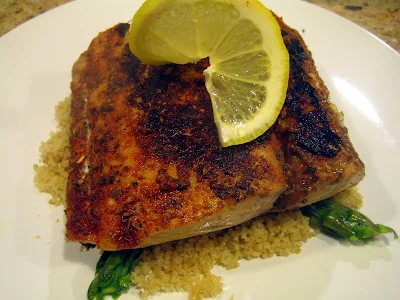We don’t usually have fish for dinner, but after trying blackened mahi mahi, we might start doing it more often. The flavors were bold and exciting, and we were surprised at how simple it was to make.
My Aunt came over and left us a couple of mahi mahi fillets. Since this fish has a nice, meaty texture, we figured a strong, smoky seasoning would work perfectly. We went with a blackened spice mix, and it turned out to be a perfect match for the fish.
This dish was quick to make, and even though I took a shortcut with the asparagus in the microwave, it still turned out great. It’s one of those meals I’ll definitely be repeating!
Table of Contents
ToggleBlackened Mahi Mahi With Couscous And Asparagus Recipe
Ingredients
For The Fish
- 2 mahi mahi fillets (around 6 oz each)
- 1 teaspoon salt
- 1 teaspoon black pepper
- 1 tablespoon paprika
- 1 teaspoon dried oregano
- 1 teaspoon onion powder
- 1 teaspoon garlic powder
- 1/2 teaspoon cayenne pepper (optional for extra heat)
- 1 teaspoon ground cumin
For The Asparagus
- 1 bunch of fresh asparagus (about 8-10 spears)
- 1/2 teaspoon salt
- 1/2 teaspoon black pepper
- 1 tablespoon fresh lemon juice (from 1/2 lemon)
For The Couscous
- 1 cup couscous
- 1 1/4 cups water (or vegetable broth)
- 1/2 teaspoon salt
For Garnish (optional)
- 1/2 lemon, cut into wedges
- 2 tablespoons fresh parsley, chopped
Instructions
For The Fish
- In a small bowl, combine the salt, pepper, paprika, oregano, onion powder, garlic powder, cayenne, and cumin.
- Rub the spice mixture generously onto both sides of the mahi mahi fillets.
- Heat a heavy-bottomed pan (such as a cast iron skillet) over high heat until it’s very hot.
- If using, add a small drizzle of oil to the pan; otherwise, place the fish directly into the dry pan.
- Cook the fish for 3-4 minutes on the first side, until a crispy crust forms. Flip the fish and cook for another 3-4 minutes, until the fish is fully cooked and flakes easily with a fork.
For The Asparagus
- Rinse the asparagus and trim the tough, woody ends.
- If the asparagus is thick, slice it in half lengthwise for more even cooking.
- Lay the asparagus in a microwave-safe dish, and sprinkle with salt and pepper.
- Microwave for 1-2 minutes, until the asparagus is tender but still has a slight crunch.
- Drizzle with fresh lemon juice before serving.
For The Couscous
- Bring 1 1/4 cups of water (or vegetable broth) to a boil in a pot. Add 1/2 teaspoon salt.
- Stir in the couscous, cover the pot, and remove from heat.
- Let it sit for 5 minutes, then fluff with a fork.
To Serve
- Place the blackened mahi mahi fillets on plates, add the asparagus, and spoon the couscous onto the side. Garnish with lemon wedges and fresh parsley.

Helpful Tips For Cooking Blackened Mahi Mahi
To get the best blackened mahi mahi, follow these simple tips that will help you achieve perfectly cooked fish every time:
- Use High Heat: Make sure your pan is really hot before you add the fish. This will help create that crispy, blackened crust without overcooking the fish.
- Don’t Overcrowd the Pan: If you’re cooking multiple fillets, cook them one at a time or in batches. Overcrowding can cause the fish to steam instead of sear.
- Watch the Timing: Mahi mahi cooks quickly, so keep an eye on it! It usually only takes 3-4 minutes per side, depending on the thickness.
- Pat the Fish Dry: Before seasoning, pat the mahi mahi fillets dry with paper towels to ensure the spices stick better and the fish cooks evenly.
- Rest Before Serving: Let the fish sit for a couple of minutes after cooking. This helps lock in the juices and keeps it moist.
Variations For Blackened Mahi Mahi
Want to switch things up a bit with your blackened mahi mahi? Here are some variations to make it even more delicious:
- Try Different Fish: If mahi mahi isn’t available, you can swap it for other meaty fish like tuna, swordfish, or snapper.
- Herb-infused Butter: After the fish is cooked, drizzle it with some melted butter mixed with fresh herbs like parsley or thyme for a flavorful twist.
- Add a Crunch: For extra texture, coat the fish in crushed nuts (like almonds or cashews) before cooking it for a crunchy crust.
- Seasoning Tweaks: Experiment with different spices like smoked paprika for a deeper flavor or lemon zest for a fresh citrusy kick.
- Switch Up the Sides: Pair the fish with a different side like roasted sweet potatoes or a garlic butter cauliflower mash for variety.
Perfect Side Dishes To Serve With Blackened Mahi Mahi
Pairing blackened mahi mahi with the right sides can elevate your meal. Here are some great options to serve alongside:
- Grilled vegetables
- Rice pilaf
- Crispy potatoes
- Coleslaw
How To Store Leftover Blackened Mahi Mahi?
If you have leftover blackened mahi mahi, here’s how to store it properly:
- In the Fridge: Let the fish cool down before placing it in an airtight container. Store it in the fridge for up to 2 days.
- For Freezing: To keep it longer, wrap the fish tightly in plastic wrap and then in foil. Freeze for up to 3 months.
- Reheat Gently: When you’re ready to eat, gently reheat the fish in a skillet over low heat to keep it from drying out. You can also microwave it, but cover it to retain moisture.
How To Tell If Mahi Mahi Is Fresh?
Knowing how to pick fresh mahi mahi is key to ensuring your meal is flavorful and safe to eat. Here are some simple ways to tell if mahi mahi is fresh:
- Smell: Fresh mahi mahi should have a clean, ocean-like scent. If it smells overly fishy or has a sour odor, it’s likely not fresh.
- Firmness: Gently press the fish with your finger. Fresh mahi mahi will bounce back and feel firm to the touch. If it leaves an imprint or feels mushy, it’s past its prime.
- Color: Fresh mahi mahi has a vibrant, translucent appearance, usually in shades of pink or light orange. If the color looks dull or faded, the fish might not be fresh.
- Moisture: The surface of fresh mahi mahi should look moist, not dry or slimy. If it looks dry or slimy, it could be a sign of age.
- Eyes: If buying whole fish, check the eyes. They should be clear and slightly bulging. Cloudy, sunken eyes indicate the fish is old.

Why Is My Mahi Mahi Rubbery?
If your mahi mahi turns out rubbery, it’s usually because of one or more of these reasons:
- Overcooking: Cooking the fish for too long can cause it to become tough and rubbery. Mahi mahi cooks quickly, usually within 3-4 minutes per side. Always check for doneness by gently pressing on the fish—it should flake easily when cooked just right.
- Too High of Heat: If the heat is too high while cooking, the outside of the fish may burn before the inside cooks through, causing the texture to become tough. Cooking over medium-high heat is ideal for even cooking.
- Fish Quality: Sometimes, if the mahi mahi isn’t fresh or was previously frozen and thawed improperly, it can turn rubbery when cooked. Always buy fresh fish and avoid refreezing fish that’s already been thawed.
Why Is My Mahi Mahi Mushy?
A mushy texture is another sign that your mahi mahi didn’t cook as it should have. Here are some reasons why mahi mahi might end up mushy:
- Overcooking or Undercooking: Just like with rubbery fish, overcooking or undercooking mahi mahi can cause it to have a mushy texture. Aim to cook it perfectly—firm but moist, flaky, and tender. If it’s mushy, it was likely undercooked or cooked too fast on too high heat.
- Thawing Issues: If you’re using frozen mahi mahi, improper thawing can cause it to lose its texture. Always thaw fish in the fridge, not on the counter or in warm water. Fast thawing causes the fish to become mushy when cooked.
- Quality of the Fish: Fish that’s been stored for too long or improperly handled (such as thawed and refrozen multiple times) can lose its structure and become mushy. Always buy fish that’s fresh and has been stored properly.










